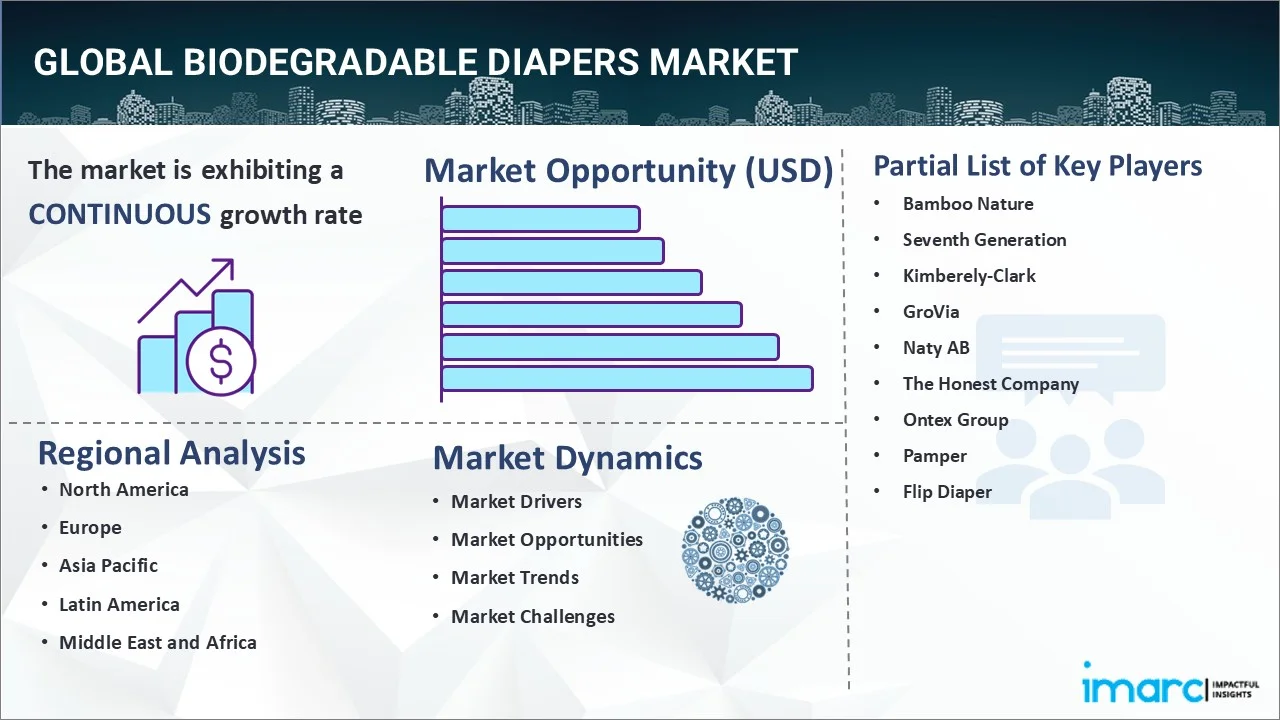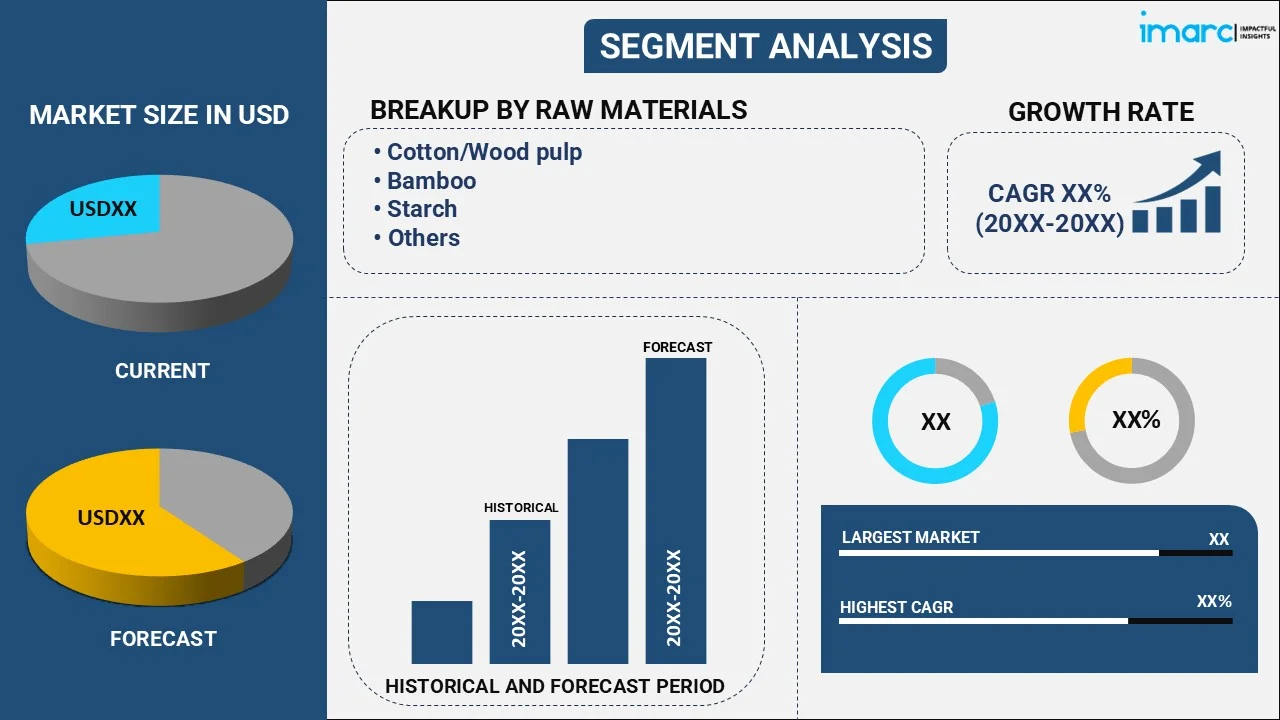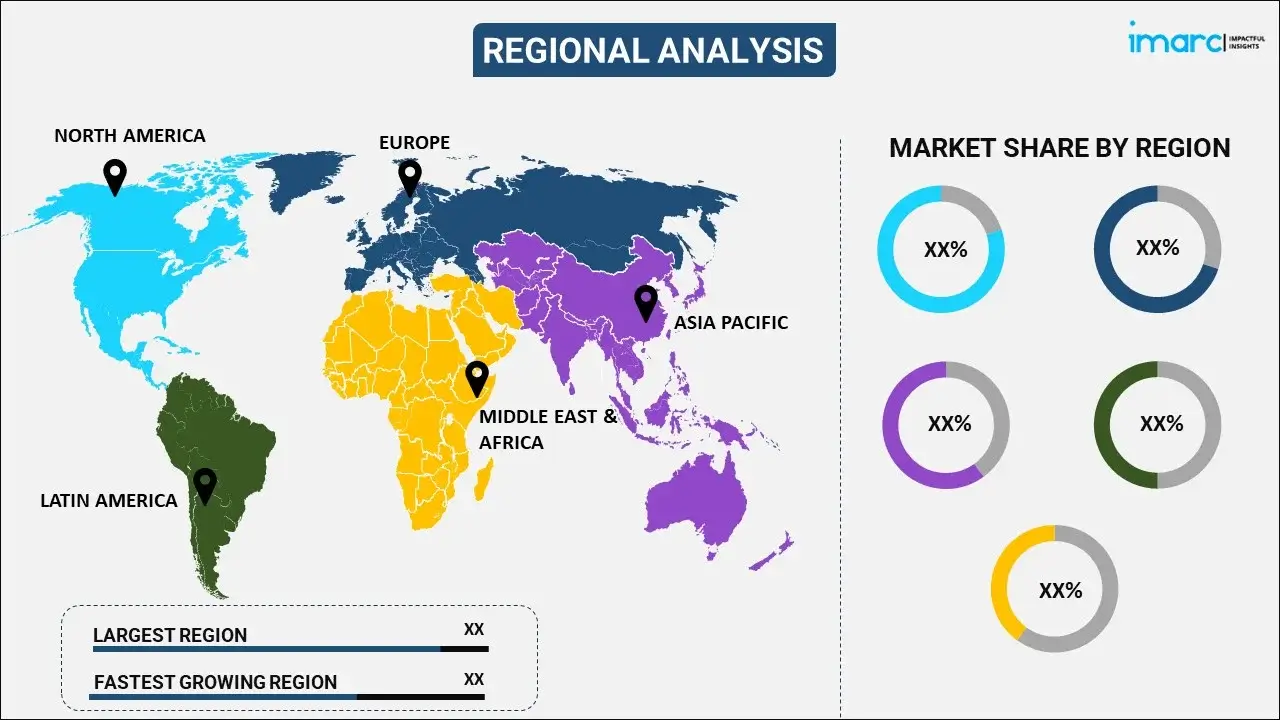
Biodegradable Diapers Market Report by Raw Material (Cotton/Wood pulp, Bamboo, Starch, and Others), End-User (Babies, Adults), Distribution Channel (Pharmacies, Supermarkets and Hypermarkets, Convenience Stores, Online, and Others), and Region 2025-2033
Market Overview:
The global biodegradable diapers market size reached USD 4.3 Billion in 2024. Looking forward, IMARC Group expects the market to reach USD 8.2 Billion by 2033, exhibiting a growth rate (CAGR) of 7.5% during 2025-2033. The growing geriatric population, increasing awareness about personal health and hygiene, and the rising prevalence of urinary incontinence represent some of the key factors driving the market.
|
Report Attribute
|
Key Statistics
|
|---|---|
|
Base Year
|
2024
|
|
Forecast Years
|
2025-2033
|
|
Historical Years
|
2019-2024
|
|
Market Size in 2024
|
USD 4.3 Billion |
|
Market Forecast in 2033
|
USD 8.2 Billion |
| Market Growth Rate 2025-2033 | 7.5% |
Rising Prevalence of Urinary Incontinence Augmenting Market Growth
The rising prevalence of urinary incontinence currently represents one of the primary drivers resulting in the increasing sales of biodegradable diapers. This is also resulting in the increase demand for biodegradable diapers, especially among the geriatric population. Moreover, the rising preference for biodegradable diapers to maintain personal hygiene among adults suffering from this disorder is bolstering the growth of the market.

Competitive analysis such as market structure, market share by key players, player positioning, top winning strategies, competitive dashboard, and company evaluation quadrant has been covered in the report. Also, detailed profiles of all major companies have been provided. The market structure is fragmented with a large number of small and medium-sized players operating in the industry. The volume of new entrants is moderate in the biodegradable diapers industry on account of the low entry barriers and product differentiation in the market. However, consumers have loyalty towards specific brands which increases the threat of new entrants in the market.
What are Biodegradable Diapers?
Biodegradable diapers refer to absorbent items that are designed to defecate and urinate without going to the toilet. They are manufactured from various biodegradable fibers, such as cotton, bamboo, wood pulp, and starch, and widely available in different sizes, shapes, colors, and designs. They are easily decomposed in the environment and can be flushed for the purpose of composting. They are convenient, cost-effective, recyclable, environmentally friendly, and have hypoallergenic and antibacterial properties. As they assist in reducing the risk of infection, skin irritation, rashes, and itching among babies and adults, the demand for biodegradable diapers is increasing around the world.
COVID-19 Impact:
The COVID-19 pandemic outbreak caused a severe problem for the biodegradable diapers industry and imposed unprecedented challenges on numerous countries. The imposition of the lockdown has forced manufacturers to halt or temporarily shut down their operations. There was a shortage of labor and raw materials due to the fear of the widespread coronavirus. In addition to this, restrictions on cross-border movements have hampered the export and import of biodegradable diapers across the globe. Governing agencies of various countries imposed stringent policies that caused serious supply chain disruptions in the biodegradable diapers industry. Apart from this, the demand for biodegradable diapers declined as consumers were focused on purchasing essential items rather than buying these diapers. Additionally, the rapid spread of COVID-19 has resulted in decreased disposable income of individuals around the world, which affected the purchase of branded baby or adult hygiene biodegradable diapers. However, post-pandemic, governing agencies of various countries have reopened the lockdown, which is projected to increase the sales of biodegradable diapers in the coming years. Moreover, the rising awareness among consumers about utilizing natural and organic products currently is positively influencing the biodegradable diaper market.
Biodegradable Diapers Market Trends:
At present, the increasing awareness about maintaining personal hygiene among individuals around the world represents one of the major factors impelling the growth of the market. Moreover, the escalating demand for biodegradable diapers due to rising environmental concerns among the masses worldwide is strengthening the growth of the market. Apart from this, the growing prevalence of urinary incontinence disorder among individuals across the globe is offering a positive market outlook. In addition to this, the rising number of geriatric populations, along with the increasing demand for natural and organic solutions that are chemical free, is contributing to the growth of the market. Besides this, governing agencies of various countries are supporting the utilization of biodegradable diapers to reduce the waste in landfills and decrease carbon footprint around the world is offering lucrative growth opportunities to industry investors. Additionally, the rising demand for biodegradable diapers among babies, as they prevent rashes and itching, is bolstering the growth of the market. In line with this, the wide availability of biodegradable diapers through various distribution channels, such as pharmacies, supermarkets, hypermarkets, and convenience and online stores, is propelling the growth of the market. Furthermore, key players are introducing innovative biodegradable baby diapers with non-chlorine, latex, and dye-free materials, which is supporting the growth of the market.
Key Market Segmentation:
IMARC Group provides an analysis of the key trends in each sub-segment of the global biodegradable diapers market report, along with forecasts at the global and regional level from 2025-2033. Our report has categorized the market based on raw material, end-user and distribution channel.
Raw Material Insights:

- Cotton/Wood pulp
- Bamboo
- Starch
- Others
The report has provided a detailed breakup and analysis of the biodegradable diapers market based on the raw material. This includes cotton/wood pulp, bamboo, starch, and others. According to the report, cotton/wood pulp represented the largest segment due to the rising awareness among individuals about maintaining hygiene. In addition, cotton or wood pup diapers are made from natural materials that do not harm the skin and prevent rashes or itching.
End-User Insights:
- Babies
- Adults
A detailed breakup and analysis of the biodegradable diapers market based on the end-user has also been provided in the report. This includes babies and adults. According to the report, babies accounted for the largest market share, as biodegradable baby diapers are manufactured from waterproof and sustainable fabrics that are skin friendly for babies. Moreover, the rising demand for biodegradable baby diapers, as they are convenient, easy to use, and cost-effective is positively influencing the market.
Distribution Channel Insights:
- Pharmacies
- Supermarkets and Hypermarkets
- Convenience Stores
- Online
- Others
A detailed breakup and analysis of the biodegradable diapers market based on the distribution channel has also been provided in the report. This includes pharmacies, supermarkets and hypermarkets, convenience stores, online, and others. According to the report, pharmacies accounted for the largest market share, as they are in and around residential areas and are a convenient point of purchase for consumers. Additionally, there is a rise in the preference for buying biodegradable diapers from pharmacists, as they provide extra advice about the product.
Regional Insights:

To get more information on the regional analysis of this market, Request Sample
- North America
- Europe
- Asia- Pacific
- Latin America
- Middle East and Africa
The report has also provided a comprehensive analysis of all the major regional markets, which include North America, Europe, Asia Pacific, Latin America, and the Middle East and Africa. According to the report, North America was the largest market for biodegradable diapers. Some of the factors driving the North America biodegradable diapers market included the growing geriatric population, rising awareness about maintaining hygiene, and increasing prevalence of adult urinary incontinence. In addition, governing agencies in the region are encouraging the adoption of eco-friendly products, which is contributing to the growth of the market.
Competitive Landscape:
The report has also provided a comprehensive analysis of the competitive landscape in the global biodegradable diapers market. Some of the companies covered in the report include:
- Bamboo Nature
- Seventh Generation
- Kimberely-Clark
- GroVia
- Naty AB
- The Honest Company
- Ontex Group
- Pamper
- Flip Diaper
Please note that this only represents a partial list of companies, and the complete list has been provided in the report.
Report Coverage:
| Report Features | Details |
|---|---|
| Base Year of the Analysis | 2024 |
| Historical Period | 2019-2024 |
| Forecast Period | 2025-2033 |
| Units | Billion USD |
| Segment Coverage | Raw Material, End-User, Distribution Channel, Region |
| Region Covered | Asia Pacific, Europe, North America, Latin America, Middle East and Africa |
| Companies Covered | Bamboo Nature, Seventh Generation, Kimberely-Clark, GroVia, Naty AB, The Honest Company, Ontex Group, Pamper and Flip Diaper |
| Customization Scope | 10% Free Customization |
| Post-Sale Analyst Support | 10-12 Weeks |
| Delivery Format | PDF and Excel through Email (We can also provide the editable version of the report in PPT/Word format on special request) |
Key Benefits for Stakeholders:
- IMARC’s report offers a comprehensive quantitative analysis of various market segments, historical and current market trends, market forecasts, and dynamics of the biodegradable diapers market from 2019-2033.
- The research study provides the latest information on the market drivers, challenges, and opportunities in the global biodegradable diapers market.
- The study maps the leading, as well as the fastest-growing, regional markets.
- Porter's five forces analysis assist stakeholders in assessing the impact of new entrants, competitive rivalry, supplier power, buyer power, and the threat of substitution. It helps stakeholders to analyze the level of competition within the biodegradable diapers industry and its attractiveness.
- Competitive landscape allows stakeholders to understand their competitive environment and provides an insight into the current positions of key players in the market.
Key Questions Answered in This Report
The global biodegradable diapers market was valued at USD 4.3 Billion in 2024.
We expect the global biodegradable diapers market to exhibit a CAGR of 7.5% during 2025-2033.
The increasing environmental concerns, along with the launch of innovative product variants that are convenient to use, comfortable to wear, and effectively soak the fluid discharge, are primarily driving the global biodegradable diapers market.
The sudden outbreak of the COVID-19 pandemic has led to the changing consumer inclination from conventional brick-and-mortar distribution channels towards online retail platforms for the purchase of biodegradable diapers.
Based on the raw material, the global biodegradable diapers market can be bifurcated into cotton/wood pulp, bamboo, starch, and others. Among these, cotton/wood pulp currently holds the majority of the total market share.
Based on the end-user, the global biodegradable diapers market has been divided into babies and adults. Currently, baby diapers exhibit a clear dominance in the market.
Based on the distribution channel, the global biodegradable diapers market can be segmented into pharmacies, supermarkets and hypermarkets, convenience stores, online, and others. Among these, pharmacies currently represent the largest market share.
On a regional level, the market has been classified into North America, Europe, Asia Pacific, Middle East and Africa, and Latin America, where North America currently dominates the global market.
Some of the major players in the global biodegradable diapers market include Bamboo Nature, Seventh Generation, Kimberely-Clark, GroVia, Naty AB, The Honest Company, Ontex Group, Pamper, Flip Diaper, etc.
Need more help?
- Speak to our experienced analysts for insights on the current market scenarios.
- Include additional segments and countries to customize the report as per your requirement.
- Gain an unparalleled competitive advantage in your domain by understanding how to utilize the report and positively impacting your operations and revenue.
- For further assistance, please connect with our analysts.
 Request Customization
Request Customization
 Speak to an Analyst
Speak to an Analyst
 Request Brochure
Request Brochure
 Inquire Before Buying
Inquire Before Buying




.webp)




.webp)












